Groundwater Impacted Storm Overflows (2024)
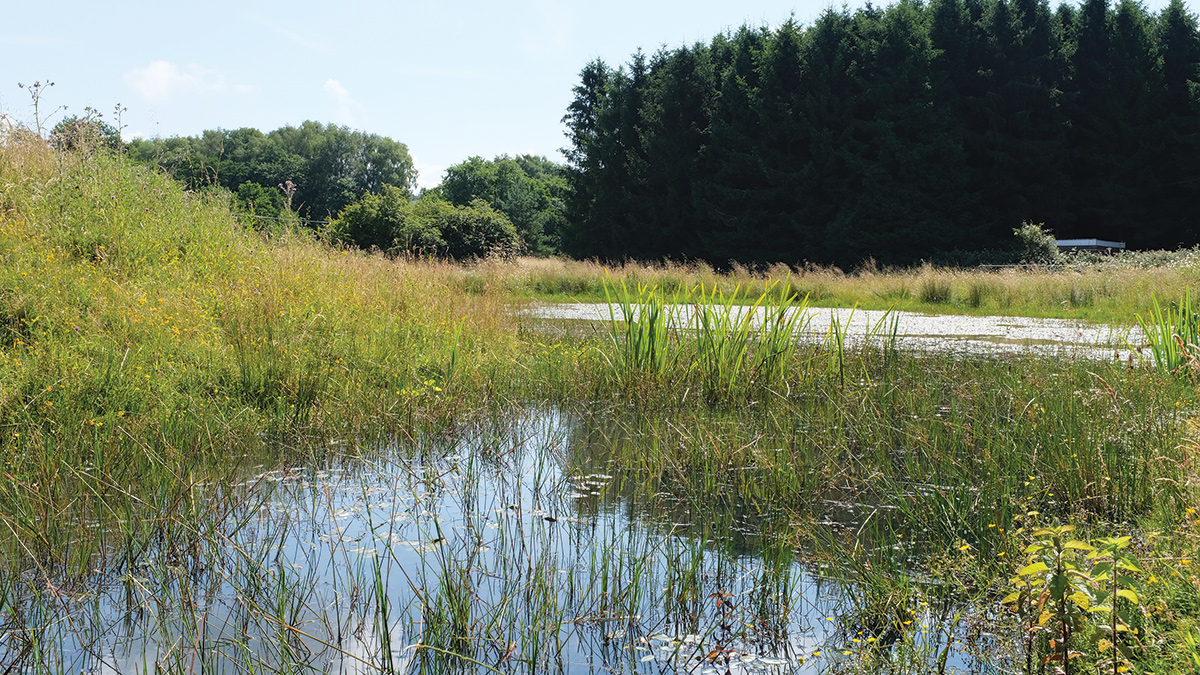
Series of connected wetland ponds - Courtesy of Mott MacDonald (David Naismith)
Storm overflows are a critical component of sewer networks, acting as relief points within the network and preventing systems from being overloaded and causing flooding. In the UK, this legacy Victorian sewer infrastructure is under growing pressures from climate change and increasing urban development. As stated in the UK Government’s ‘Storm Overflows Discharge Reduction Plan’ (SORP) (Defra, 2023), reducing storm overflows and improving water quality is a core part of the largest infrastructure investment in UK history. To address this, Wessex Water Services Limited (WWSL) is integrating Nature-based Solutions (NbS) as key interventions into their asset base through their commitment to restoring the environment.
Background
Mott MacDonald (MM) has been working closely with WWSL to assess several of their storm overflow sites for installation of constructed treatment wetlands. MM is designing both traditional and innovative wetland approaches to deliver schemes at different scales and approaches, whilst maximising sustainability through retrofitting existing and decommissioned infrastructure.
The focus of this case study is to outline the regulatory drivers, the overall design approach taken by MM and detail how the design has gone beyond simply seeking to limit environmental impact.
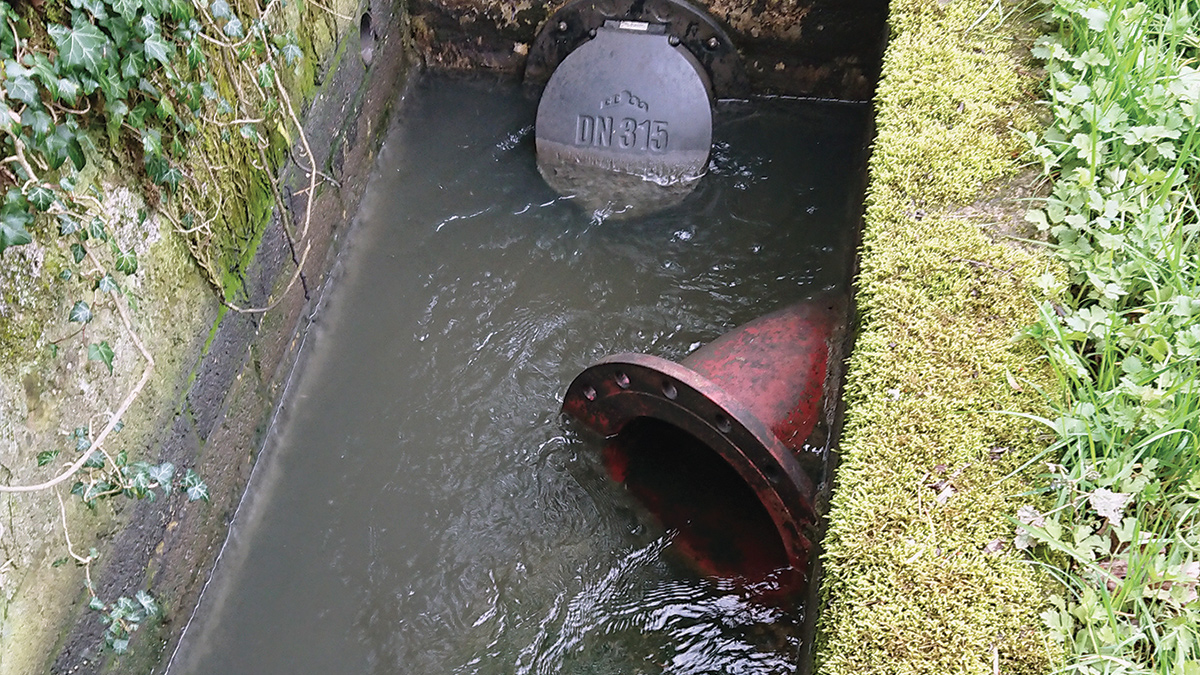
Example of a separated storm overflow and final effluent discharge point – Courtesy of Mott MacDonald (David Naismith)
Regulatory drivers
Under the Environment Act 2021 (Parliament of United Kingdom), all water companies in England are legally required to progressively reduce the adverse impacts of discharges from storm overflows. Under the SORP (2023), all water companies are required to achieve the following three specific targets:
- By 2035, water companies will have improved all storm overflows discharging near every designated bathing water and improved 75% of storm overflows discharging into or near ‘high priority sites’.
- By 2045, water companies will have improved all remaining storm overflows discharging into or near ‘high priority sites’.
- By 2050, no storm overflows will be permitted to operate outside of unusually heavy rainfall or to cause any adverse ecological harm.
These targets need to be achieved in addition to all legal duties stipulated under the Urban Waste Water Treatment Regulations (England and Wales) (1994) and the Water Industry Act (1991).
Storm overflow operation is influenced by rainwater and/or groundwater contributions. Where groundwater is the key contributor causing the overflow to operate, often for prolonged periods of time, NbS can provide treatment to ensure no adverse ecological harm. This aligns with the requirements set out in the relevant legislation.
Suitable regulation is and will be key to ensuring wetlands are appropriate and adequately designed to address needs. Wessex Water has been working with Defra and the Environment Agency to develop a permitting approach suitable for use at their sites with groundwater influenced storm overflow wetlands. It is anticipated that through using existing wetland sites as research and case study systems, under Operating Techniques Agreements (OTAs), suitable permitting can be developed for future use.
To date, there is a requirement to satisfy the requirements of the Urban Wastewater Treatment Regulations (England and Wales) (1994), specifically Schedule 3 Table 1, which sets out effluent quality requirements with respect to BOD5 and demonstrate that the Best Technical Knowledge Not Entailing Excessive Cost (BTKNEEC) tests have been satisfied.
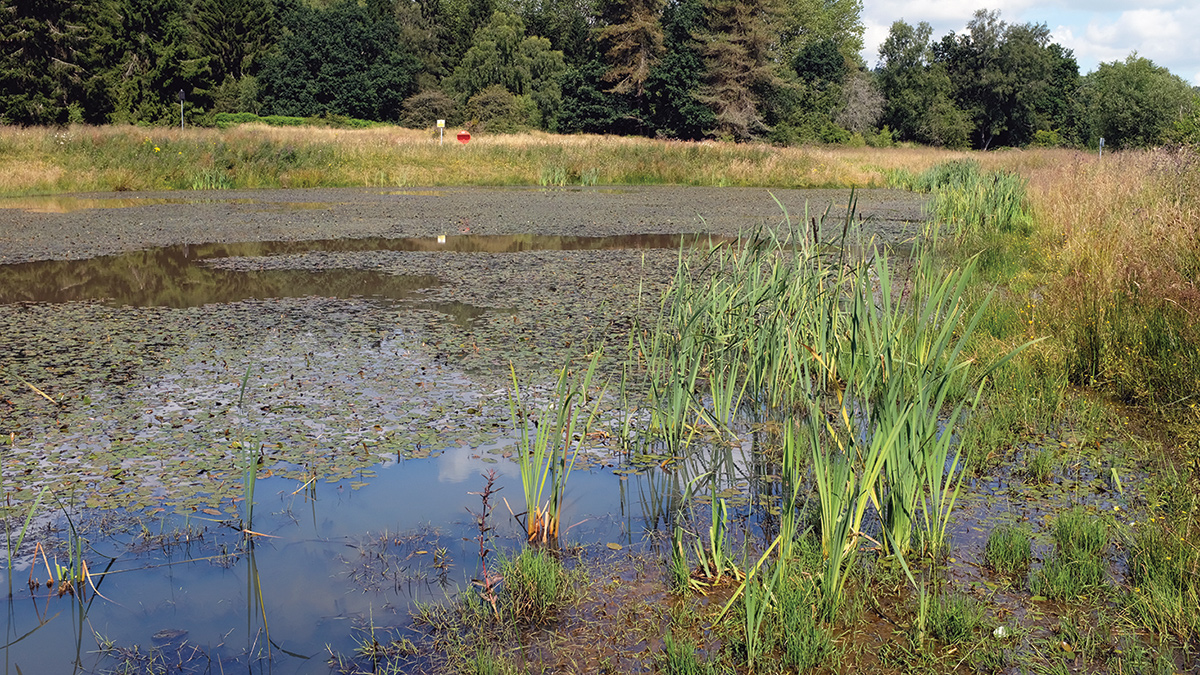
Example of a wetland with established vegetation – Courtesy of Mott MacDonald (David Naismith)
Design approach – phased delivery
Since 2022, Mott MacDonald has assisted Wessex Water to review their most frequently spilling groundwater induced storm overflows and assess the suitability of each for the installation of constructed treatment wetlands. Overflows that are governed by groundwater infiltration into the sewerage system in the upstream catchment typically exhibit a lower peak flow and overflow for a longer duration. Initial screening was undertaken to derive a candidate list of sites – where installation of treatment wetlands may be a feasible option to reduce untreated discharges to the environment and prevent subsequent ecological degradation of the receiving waterbody. This screening primarily consisted of the review of all available data sets (e.g., storm overflow water quality, quantity, and spill frequency data) and undertaking initial site visits.
It is recognised that the use of treatment wetlands systems in Europe to treat storm overflows has occurred, but their use in the UK is limited. The integration of non-traditional and unfamiliar technology within the UK water industry comes with associated risks and opportunities. Wessex Water has used a phased delivery approach which allows for a gradual implementation, facilitating easier planning and control of delivery. Key blockers are identified at the initial stages of delivery, allowing for issues to be solved with a minimised impact and will make the process smoother in the long run. A staggered approach has allowed for the growth of expertise and capacity, development of efficiencies and best practice and lessons learnt to be implemented from earlier phases.
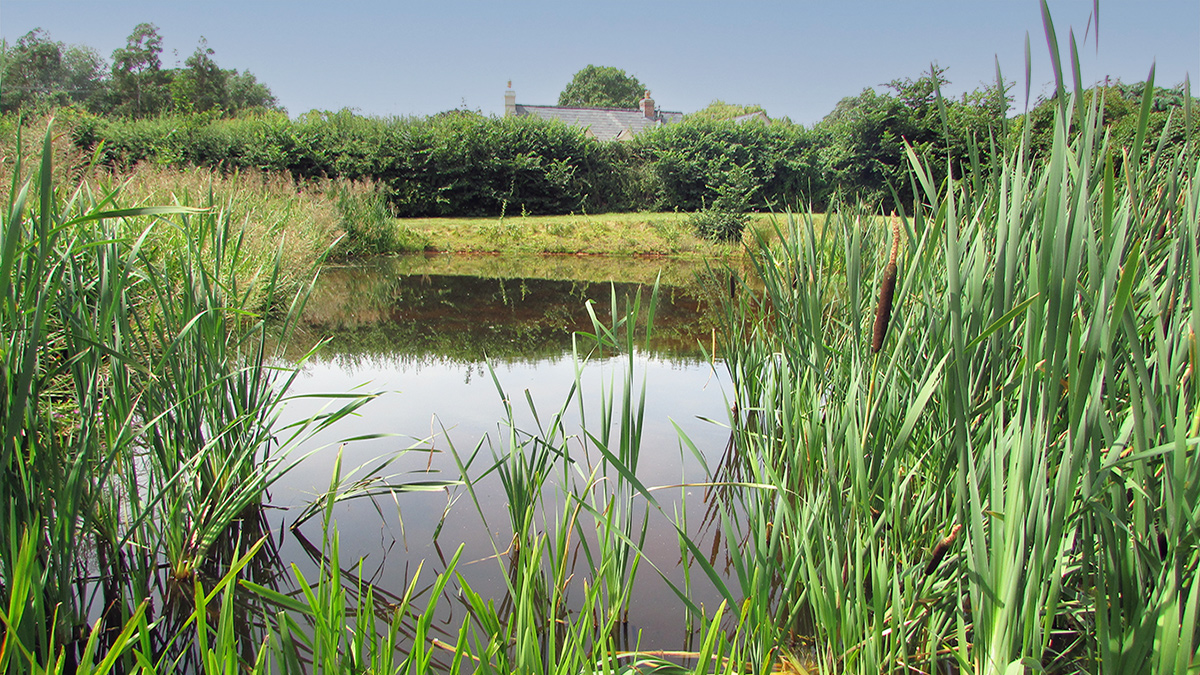
Soft engineered bank, pond and marginal planting – Courtesy of Mott MacDonald (David Naismith)
Overview of constructed wetlands solutions
There is good evidence of the use of constructed wetlands (CWs) for treating storm overflows in Europe and the USA, with the most recent information available for systems in Germany, Italy, France and the USA. At present there is little published literature on the use of CWs for CSOs/SOs for the UK.
One of the first storm overflow filters was built in Germany in 1989, these were referred to as Retention Soil Filters (RSF) as they were constructed with a soil and compost filter media. Following early experience with these systems, the filter media was changed to technically mixed sands to prevent clogging (Meyer et al., 2013).
The German Association for Water, Wastewater and Waste (Deutsche Vereinigung fur Wasserwirtchaft, Abwasser und Abfall, DWA), released national guidelines on design and operation in 2005, based on the improved RSF design with sands and gravels as the filter media. These guidelines were updated in 2018 (DWA, 2018; Nivala et al., 2018) based on the experiences since the first issue. Further development of the design of storm wetlands in France and Italy began in the late 2000s, with national guidance being produced.
Treatment process
A typical storm overflow wetland is installed between the overflow point from the storm tank and the existing storm outfall. Irrigation flow can be taken from the final effluent stream or a potable water source. The figure below illustrates a flow diagram for an example site with Vertical Flow (VF) wetlands installed. It should be noted that at some sites, storm overflow and final effluent share a common outfall to an adjacent watercourse.
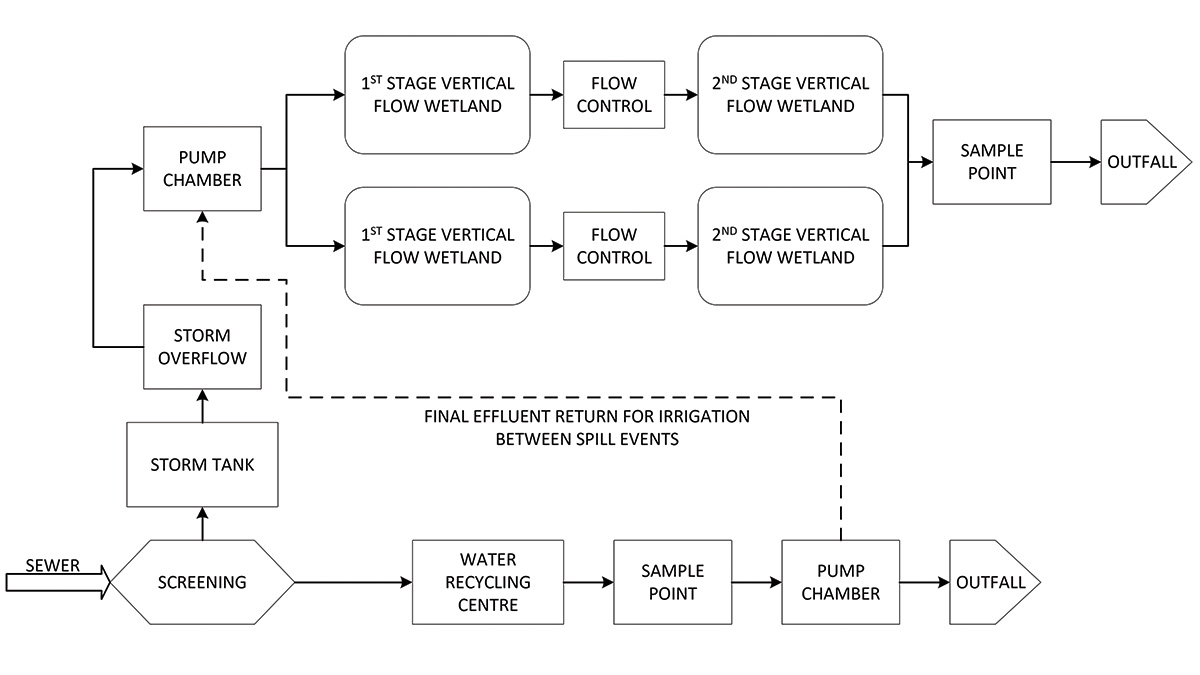
Example treatment process of a vertical flow wetland used to treat storm overflow – Courtesy of Mott MacDonald (David Naismith)
The typical performance for CSO/SO wetlands is provided in the table below.
The pollutant reductions ranges are derived from a review of literature and cover a range of system configurations but provide a general indication of the water quality improvements that can be expected.
| Parameter | Typical Reduction Range | Parameter | Typical Reduction Range |
| Total suspended solids | 50-95% | Nitrate | 45-50% |
| Biological oxygen demand (BOD) | 60-90% | Total phosphorus | 40-90% |
| Chemical oxygen demand (COD) | 80-90% | E. Coli | 1.2-2.3 log10 |
| Ammonia | 40-90% | Enterococci | 0.9-2.2 log10 |
| Typical Performance of CSO/SO Wetlands | |||
Wetland types
Selection of the type of treatment wetland to be implemented has been very site specific, as each site has offered unique challenges and opportunities, though with some commonality. Typical constraints have been land area available, topography (especially levels of existing chambers where flows have to be intercepted), ecological aspects, and existing services.
The design has sought to select the most suitable wetland type for each site. The following wetland types are being designed by MML and are elaborated upon in the following sections:
- Free water surface (FWS) wetlands.
- Vertical flow (VF) wetlands.
- Floating treatment wetlands (FTW).
- Swales and bioswales.
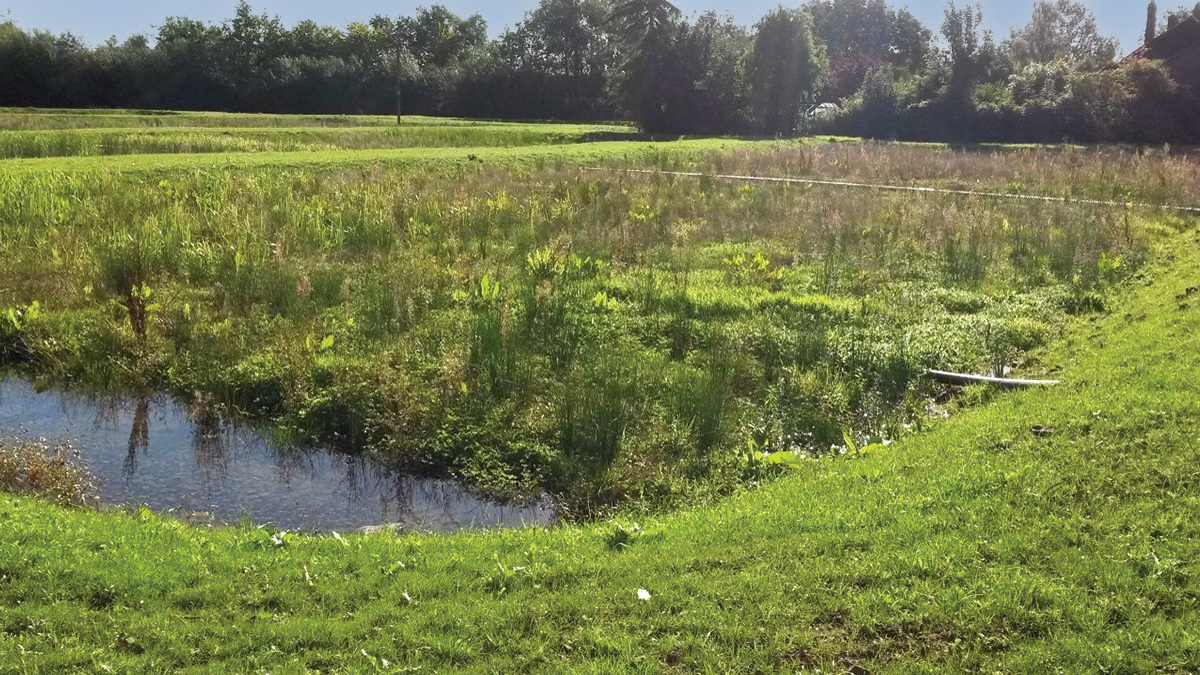
Example of a free water surface wetland – Mott MacDonald (David Naismith)
Free water surface (FWS) wetlands
This type of wetland most closely resembles natural wetlands and take the form of a marsh habitat. They consist of soil media in the base, a permanent flooded water depth of at least 300-500mm and are usually densely planted with mixed native species of submerged, emergent, and marginal aquatics. These wetlands are typically used for secondary and tertiary treatment and are effective at reducing BOD, COD, oxidised nitrogen, total phosphorus, and suspended solids concentrations.
FWS wetlands are good for high flow sites as attenuation capacity can be built in, they are continuous flow so do not require measured volumes or inflow control like VF wetlands. They do require a larger surface area and land-take than VF wetlands so are only suitable on sites where land is available, and the soils and topography are favourable. They can be incorporated into the landscape and designed to reflect more natural wetland features, so can appear less engineered than VF wetlands with less visual impact.
Vertical flow (VF) wetlands
VF wetlands consist of a sand and gravel filter with wetland plant species (typically Common Reed ‘Phragmites australis’) present on the surface. Influent is delivered in measured volumes to the surface of the wetland where it floods the top sand layer to a design depth. The influent then filters vertically down through the sand and gravel layers receiving treatment before being collected in the base of the wetland and directed to the next downstream stage. These wetlands usually operate in a minimum configuration of two cells that are alternately fed with influent, with each cell having a rest period between feedings. These wetlands are particularly effective at reducing biological oxygen demand (BOD), chemical oxygen demand (COD), and ammonia concentrations.
VF wetlands provide high performance for area footprint but do require wastewater to be delivered in measured volumes, therefore pumping or gravity siphons are required. They were selected where space was limited, and available flow data indicated they would be suitable.
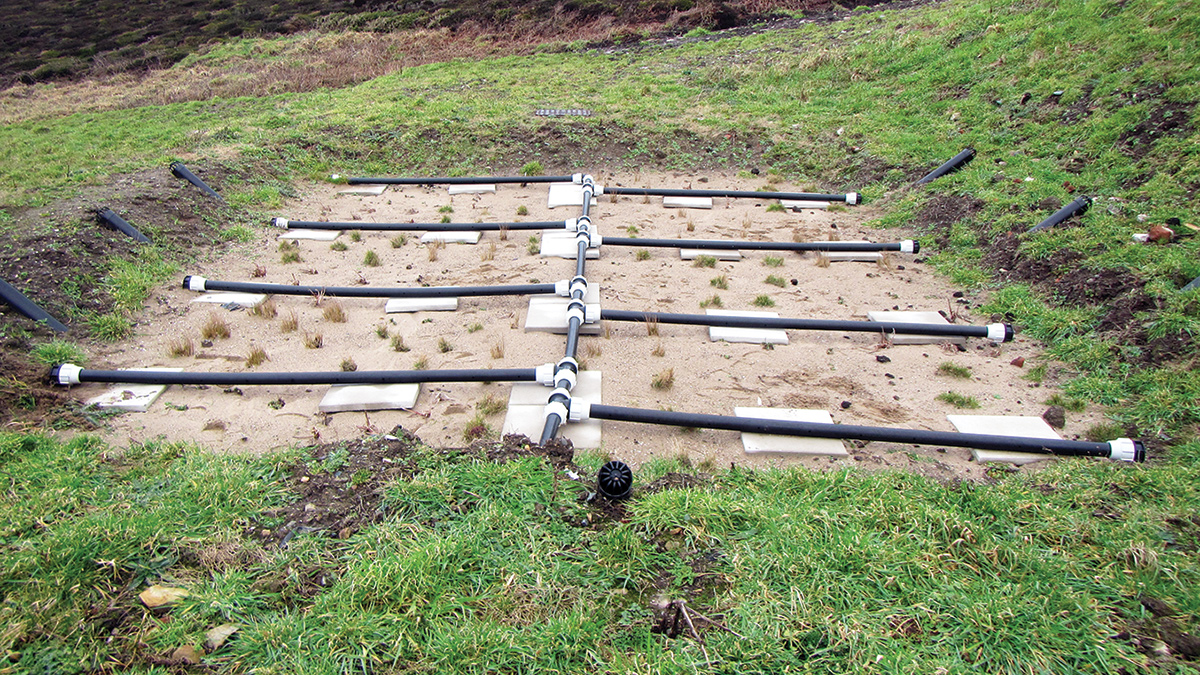
Example of a vertical flow wetland – Mott MacDonald (David Naismith)
Floating treatment wetlands (FTW)
This type consists of module units that comprise a floatation and substrate support system, planting substrate, and plants. They are typically installed on open water areas with multiple anchoring points to the bed and/or banks to hold them in position. They have the advantage of being able to accommodate relatively large fluctuations in water level while providing water quality improvement and ecological benefit. They can be used to improve the performance of settlement ponds by promoting greater suspended solids removal.
The modules are fabricated off site with media installation and planting undertaken on site. The modular construction, ability to build different configurations and shapes, and low infrastructure requirements make FTWs an effective solution for retrofitting to existing ponds, lagoons and tanks.
Swales & bioswales
Traditionally used for sustainable drainage systems (SuDS) applications, dry and wet swales are shallow ditch like features with dense vegetation. Bioswales are deeper features with a saturated, anaerobic zone in the base. Swales have been considered here in specific situations where spill volumes could be low, space is limited and irrigation between events is a challenge, as they are more resilient to dry periods. Adopted from the Catchment Sensitive Farming (CSF) approach, they are proposed on an experimental basis for network pump stations and low volume spilling sites to improve water quality and reduce impact on the receptor. However, they are likely to have lower water quality improvement potential than the other wetland types.
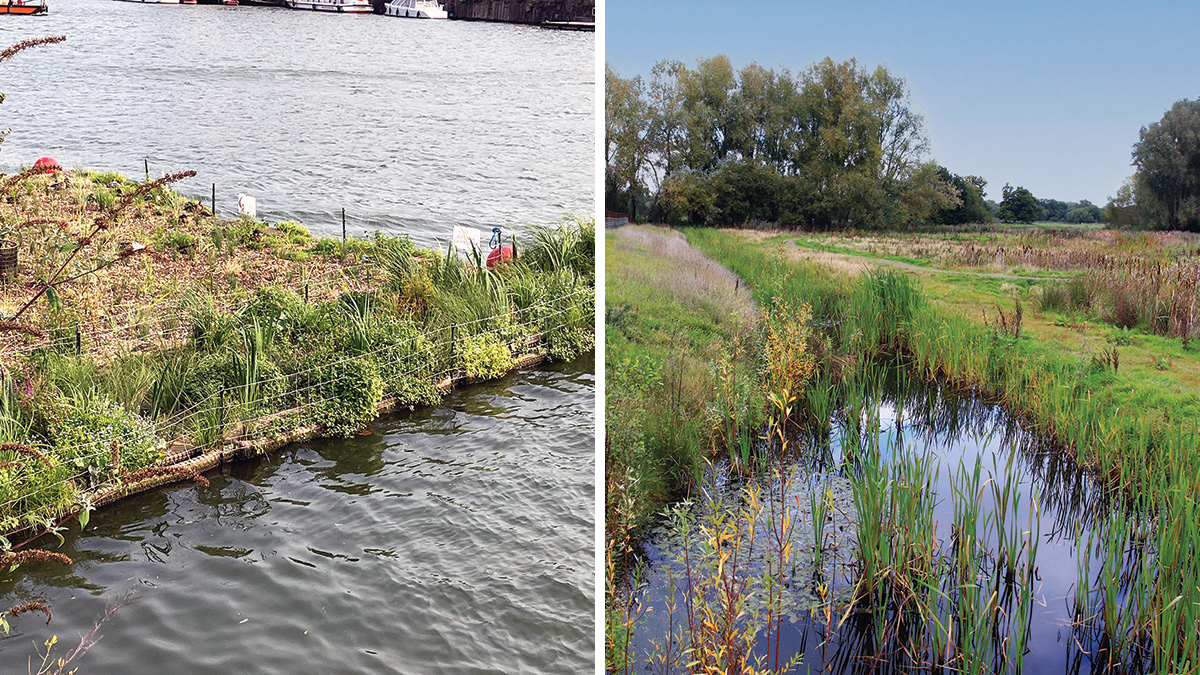
(left) Example of a floating treatment wetland – Courtesy of Biomatrix Water and (right) example of a swale – Courtesy of Mott MacDonald (David Naismith)
Wider benefits during solution development
An appropriate balance between grey and green infrastructure has been sought during design development at existing Wessex Water WRCs (water recycling centres) and SPSs (sewage pumping stations). The design approach of the schemes has focused on wider benefits alongside reducing construction, carbon, and energy requirements. The team has taken a collaborative approach to design working with multiple stakeholders and disciplines, including operational and specialist technical teams, statutory agencies, contractors, and suppliers. This included early engagement, where possible, to mitigate risks and maximise opportunities.
Retrofit & reuse
Where possible, the design has investigated the use of existing but decommissioned or under-used infrastructure for the installation of wetland systems. This has included the conversion of disused sludge or filter beds into vertical flow (VF) wetlands and re-use of redundant storm tanks or oxidation ditches into floating treatment wetland (FTW) settlement tanks. If existing infrastructure can be re-purposed where possible, this will reduce materials and construction costs and potentially reduce carbon impacts. The other advantage is to utilise space within sites more effectively, reducing the potential land take of a system and the need to purchase further land outside of the works.
The design process has also sought to maximise reusing material, such as biofilter media, to encourage responsible material consumption, reducing the required transport and volume of material sent to landfill.
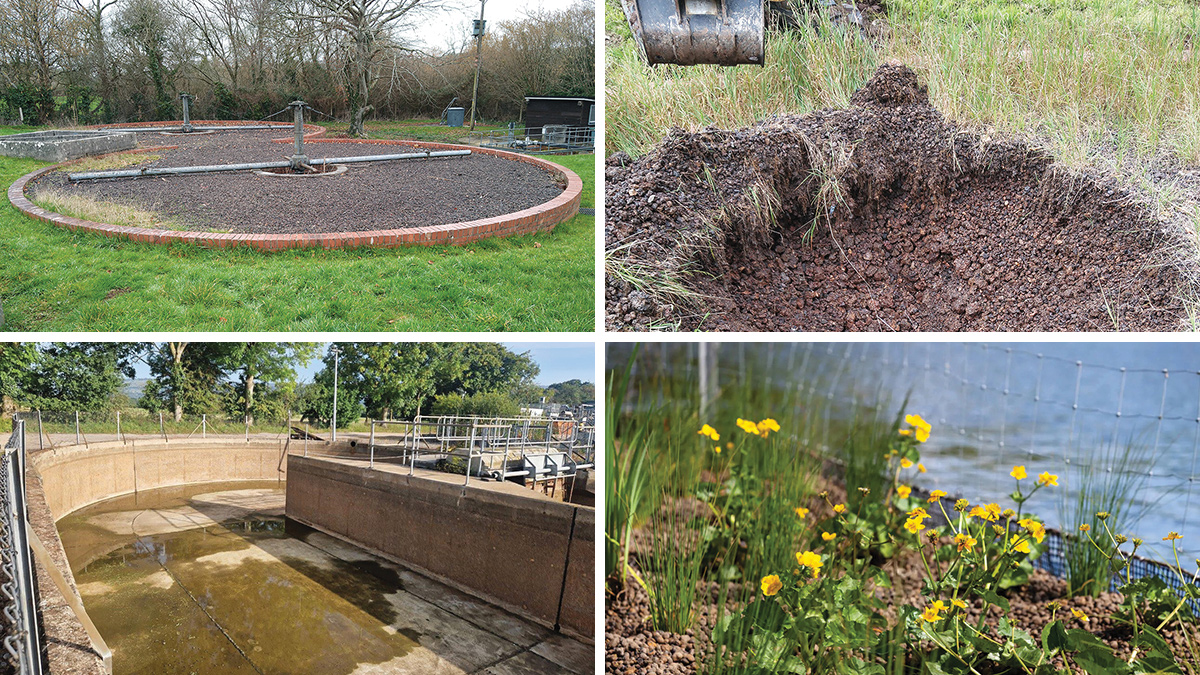
(top left) Decommissioned filter beds being considered for retrofit, (top right) filter media being considered for reuse, (bottom left) decommissioned oxidation ditch being considered for retrofit – All courtesy of Wessex Water, and (bottom right) planting within an existing floating wetland – Courtesy of Mott MacDonald
Sustainability
The design has considered the whole life cycle of the wetland and mitigated the risk of potential degradation of habitat during dry periods when selecting the type of wetland to be installed at a site and irrigation required. To reduce energy consumption, designs have been exploring the use of renewable energy using solar pumps for irrigation of wetlands during dry summer periods. Where topography and site constraints have allowed, the designs have sought to install gravity systems to avoid pumping and have adopted greener engineering solutions to provide additional value and sustainability benefits.
Where possible, the designs include viewing platforms and interpretation boards for recreational users of adjacent land to use to view and learn about the proposed wetland and surrounding area. The incorporation of these elements provide opportunities to educate on the importance of water management and biodiversity and also directly benefit people’s wellbeing through the creation of interactive spaces.
The design process has considered how multiple benefits for local wildlife and enhancements to existing habitat could be achieved. The use of soft engineered banks to retain wetlands has been prioritised where land and site-specific constraints allow. This, in addition to planting of mixed native species with attention to locally important species, has the potential to support the local ecosystems and enhance biodiversity. Where excavation has been unavoidable, enhancements such as: utilising excavated chalk to enrich surrounding chalk grassland; creation of butterfly and invertebrate mounds; and strategic planting have been included in the design. For example, at Maiden Newton WRC, the design includes scrub planting for the enhancement of local reptile habitat and hedge planting and management, using traditional hedge laying techniques, to both screen the existing WRC works and provide ecological, landscape, and heritage educational opportunities
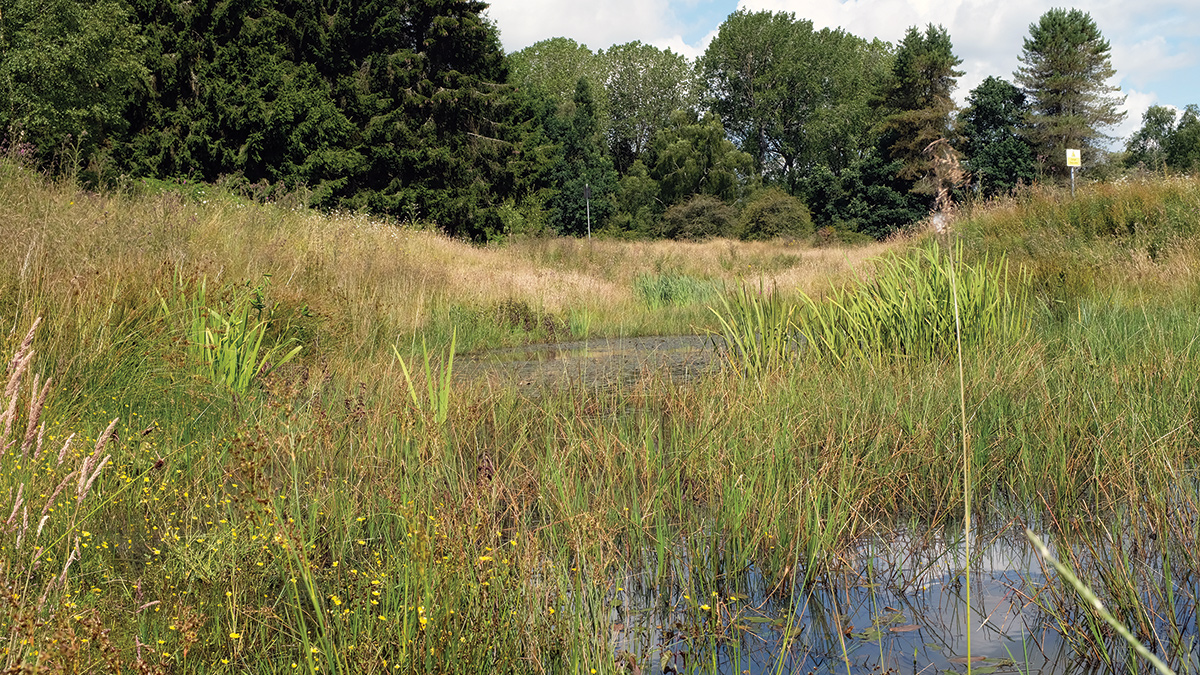
Soft engineered bank, pond and with established vegetation – Courtesy of Mott MacDonald (David Naismith)
Conclusion/summary
Working towards achieving targets set out in the SORP, Wessex Water is trialling NbS schemes across the region which shall inform the long term NbS strategy. The systems will be monitored for performance but also for ease of operation and maintenance. This monitoring will feed into capturing performance trends, lessons to be learnt and efficient maintenance operations. The information captured can then be fed back into various elements of the business to inform the development of NbS for this application.
From this, there is potential to educate and inform the national narrative and provide the evidence for other water companies to take up these solutions. Promoting the wider benefits (biodiversity, carbon, energy reduction, research, and education), resilience to climate change impacts and landscape fit, backed up with evidence, should increase the uptake of NbS within the water industry.
At time of writing (August 2024), Mott MacDonald has commenced design on a total of 11 sites whose construction phase is programmed to occur in AMP8 (2025-2030) and AMP9 (2030-2035).
The list below provides a high-level overview of the types of wetlands being designed for the sites*.
- Gurney Slade SPS: Swale with engineered soil.
- Bradford on Tone WRC: Vertical flow wetland.
- Hatch Beauchamp WRC: Bioswale (deep swale with engineered soils and a saturated, anaerobic zone).
- Maiden Newton WRC: Combination of vertical flow & free water surface wetlands.
- Wookey WRC: Re-purposing of decommissioned filter beds and retrofit with a vertical flow-style wetland using existing filter bed media.
- Cheddar WRC: Re-purposing of decommissioned oxidation ditch and retrofit with floating treatment wetland.
- North Cadbury WRC: Vertical flow wetland and/or bio-bed or bioswale.
- Sydling St Nicholas WRC: Potential short term swale solution and long term vertical flow wetland.
- Chew Stoke WRC: Re-purposing of decommissioned primary settlement tanks and creation of a free water surface wetland.
- Hullavington WRC: Vertical flow wetland.
- Great Badminton WRC: Free water surface wetland.
* Subject to change upon receipt of surveys and/or review of guidance pertaining to permitting and monitoring requirements for storm overflow treatment wetlands, anticipated to be released by the Environment Agency in 2024.
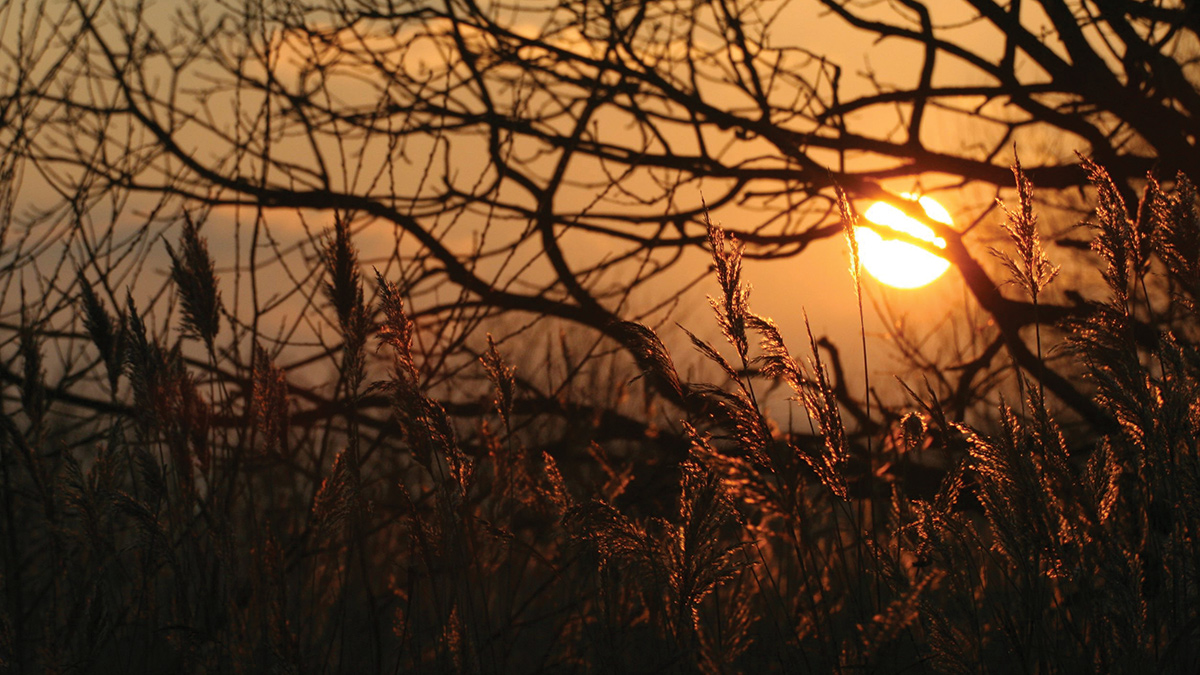
Example of planted reeds - Courtesy of Mott MacDonald (David Naismith)



